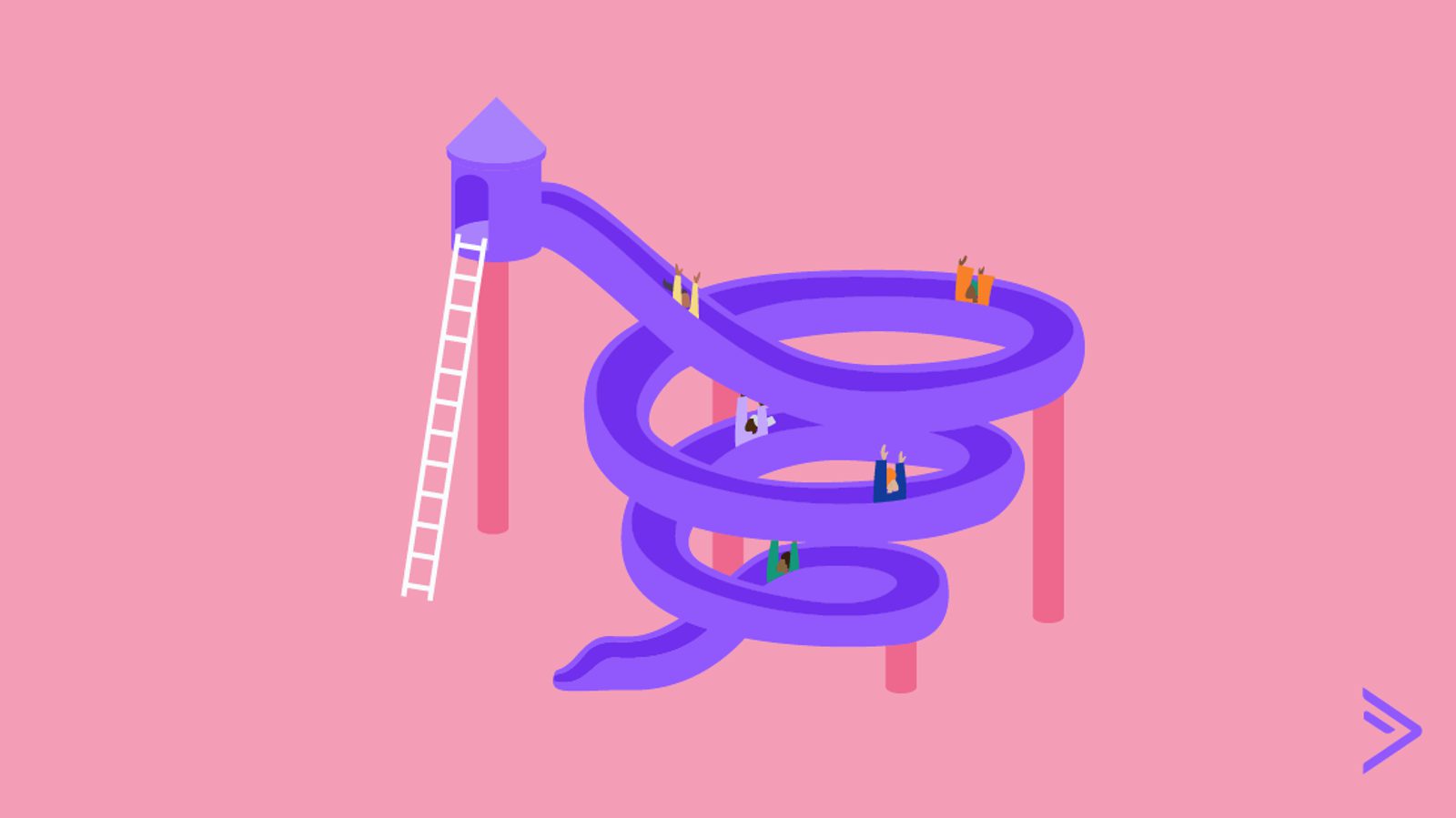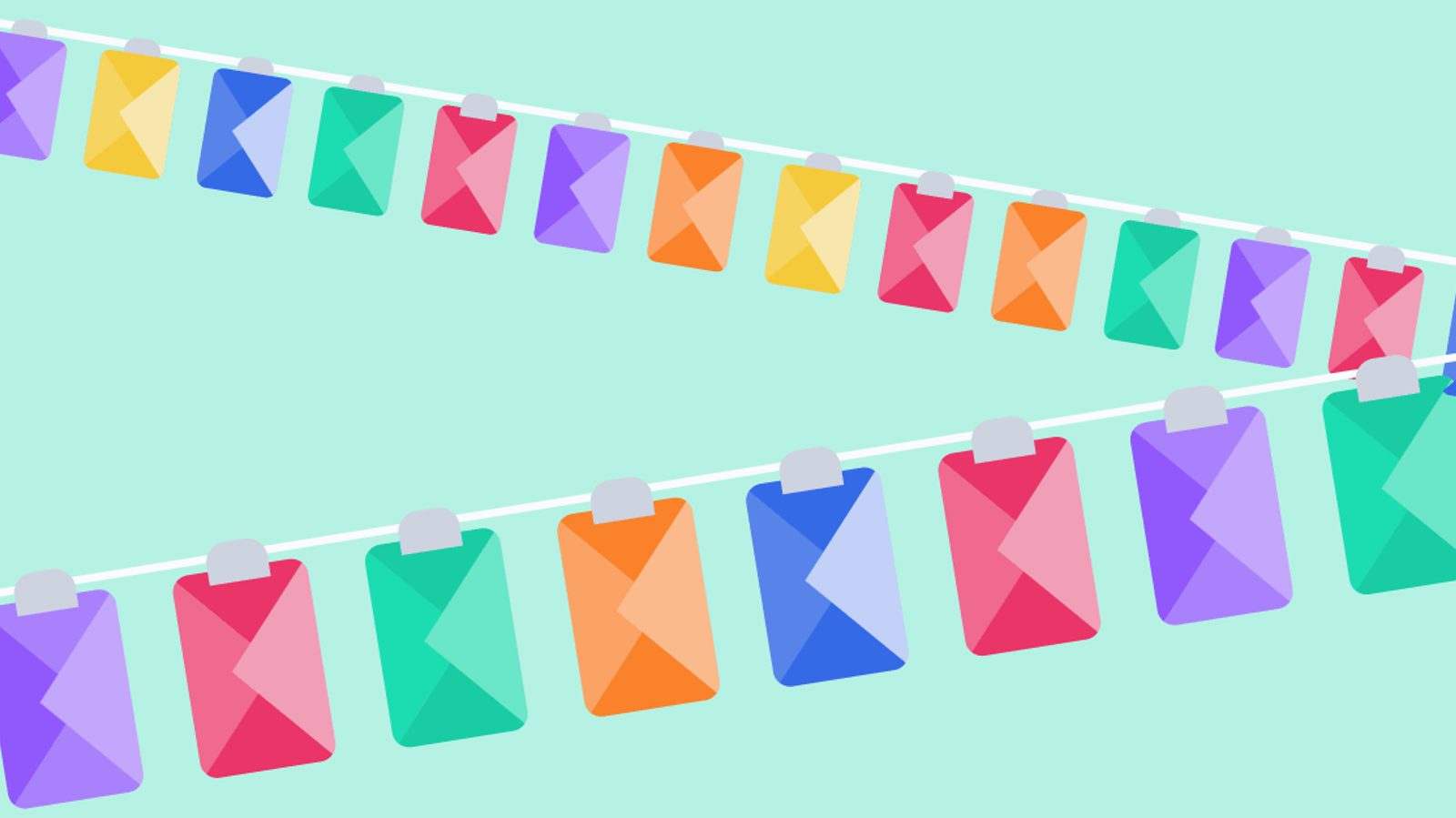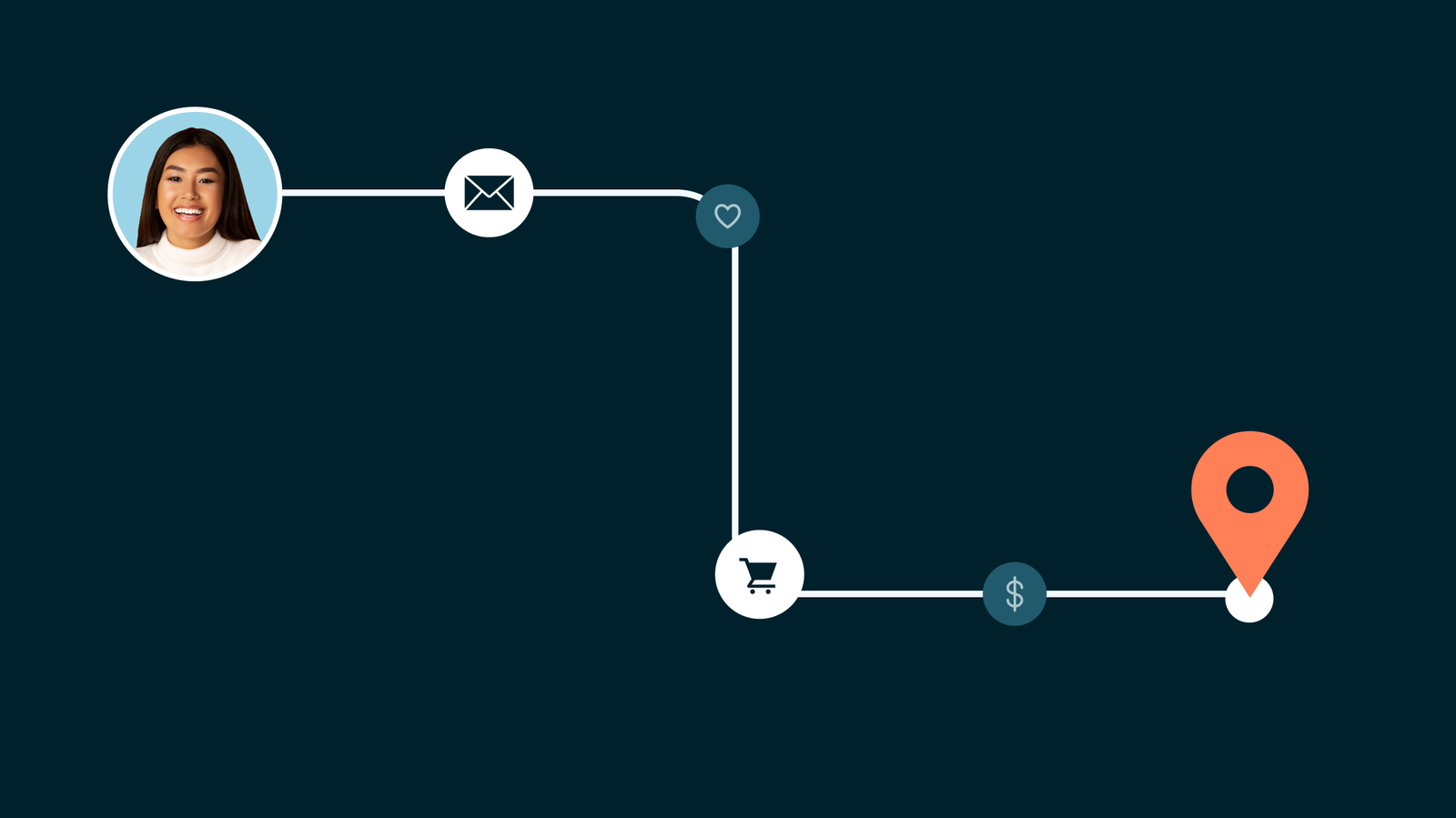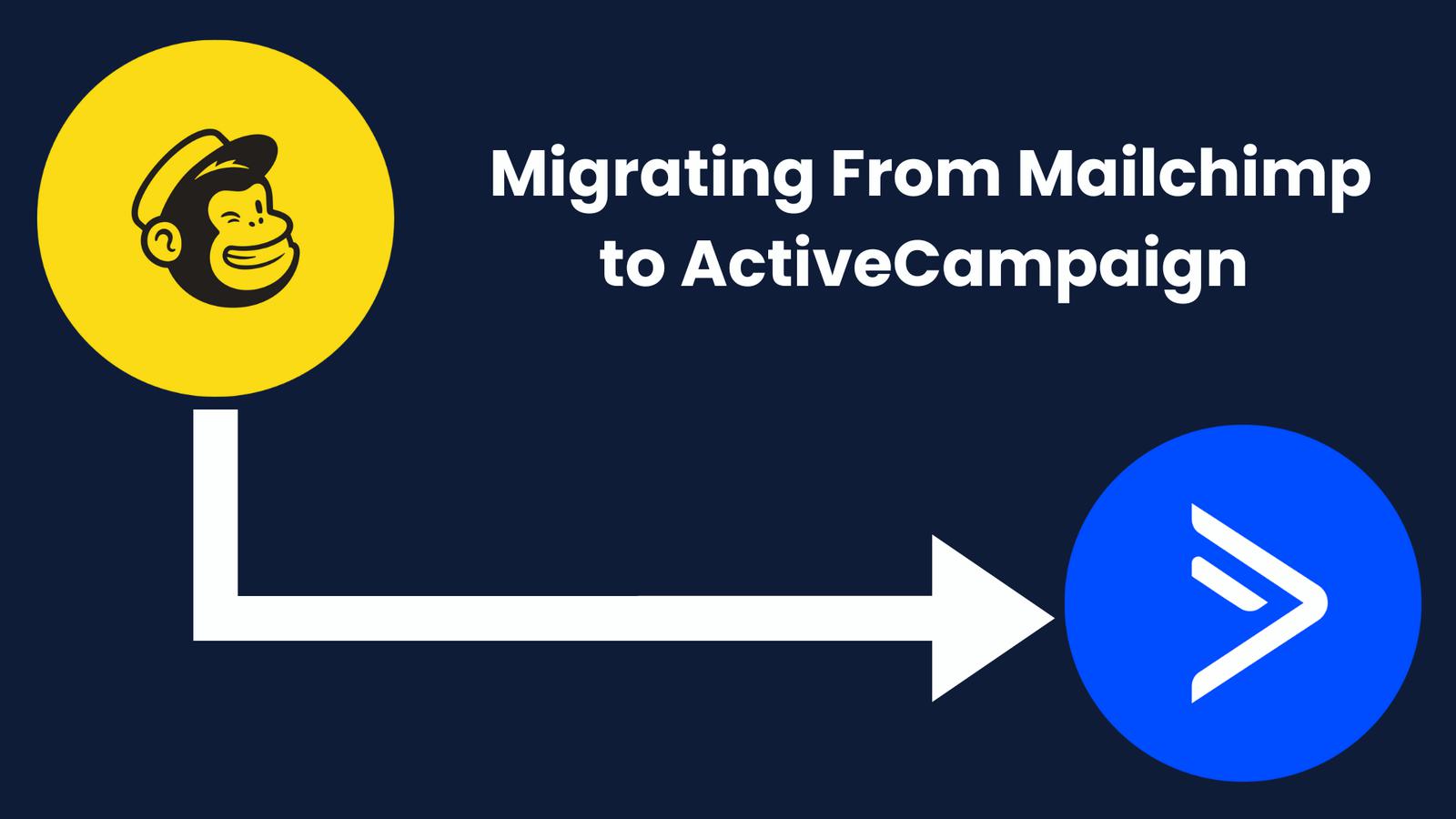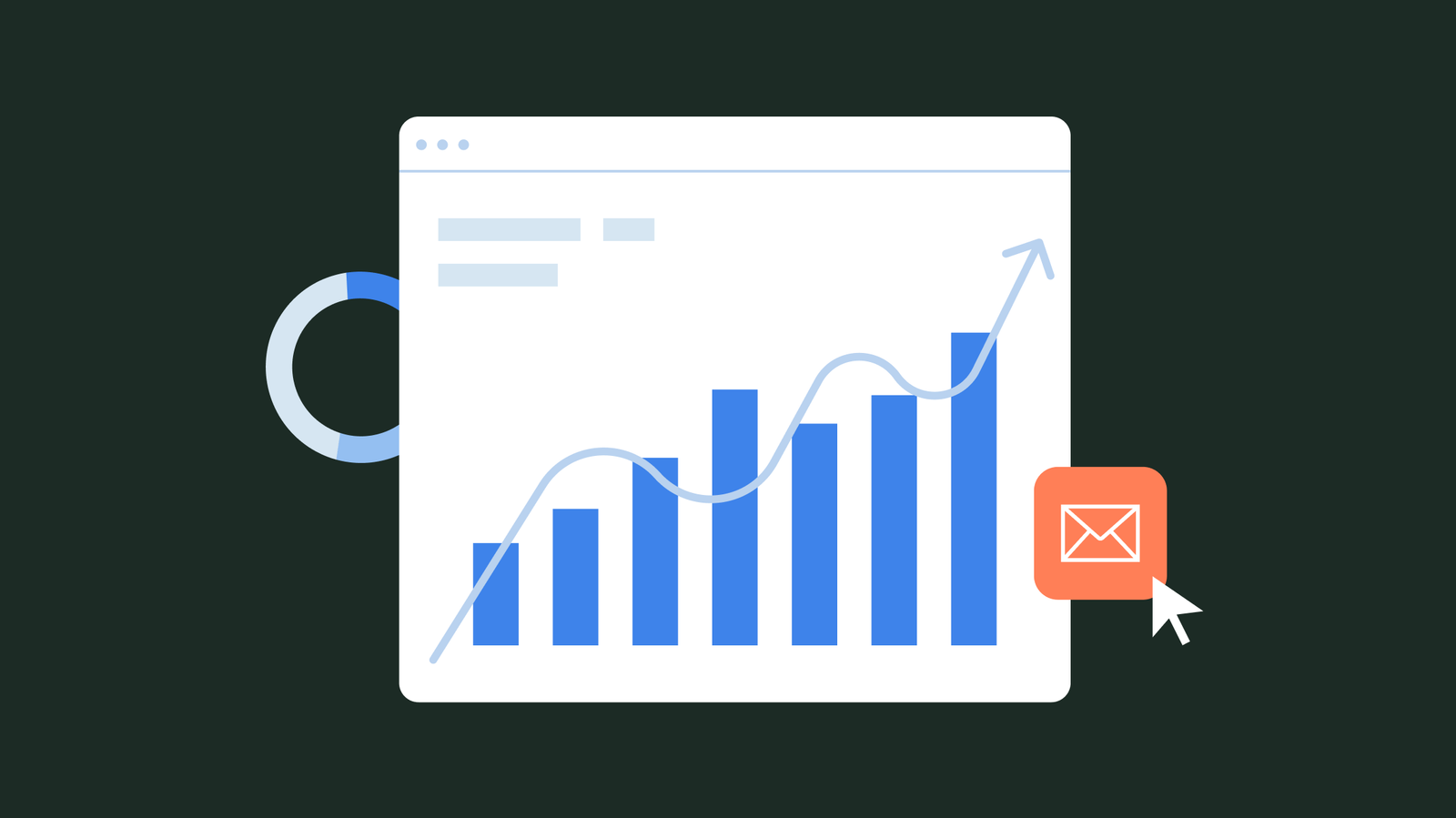When email marketing meets automation, you can create funnels that generate huge sales and profits while you sleep.
Or so you’ve heard.
The reality of automated emails is a bit trickier than it seems at first. When email funnels work, they’re powerful. The case studies are everywhere.
Automation is the latest craze.
But there are a lot of stumbling blocks before you create a funnel that converts, and a lot of questions.
- How many emails should you send?
- What should you be putting in each email?
- Will you send different messages to different members of your audience?
- How do you get people to buy?
Your contacts want to hear from you. In a survey by MarketingSherpa, 91% of people wanted to get promotional emails from companies they do business with.
Email can boost your business. McKinsey and Co report that email is 40x more effective than social media. The Direct Marketing Association reports a $38 return per dollar invested in email.
Email is incredibly trackable. You can see the dollars come in, watch every action each subscriber takes, and adjust your marketing accordingly. Those results are waiting on the other side of these email questions.
You’re about to find some answers.
This post will show you:
- A deep strategy that totally changes how you think about emails that convert
- Examples of emails you can steal for your funnel
- Persuasion techniques that get sales – including popular tactics you may want to avoid
- Segmentation and Personalization. Behind the scenes of what these phrases mean and how they magnify your results
- How to plan an email funnel – and never wonder what to send
By the time you finish reading, you’ll know how to sell to any member of your audience. You’ll understand the deep psychology of email, and how to create funnels that grow your business.
Let’s get started with the five fundamentals of a great email funnel.
What makes a great email funnel?
A great email funnel can lead to great sales numbers, but what makes an email funnel effective?
You can talk about optimizing for deliverability, curiosity-inducing preheader text, A/B testing email subject lines, and a variety of tactics to improve your open rates.
Once your emails get opened, you can join the debate about design-heavy emails vs text-based emails. Buttons or text links? Colorful or plain?
All of those tactics have their place. Optimizing the nitty gritty of your email marketing can definitely improve the performance of your email funnels.
And, once you’ve put together an email marketing strategy, it’s absolutely worth testing all of these factors.
But there’s only so much mileage you can get out of little tactics. To get the 40:1 results that email marketing promises, you need to start with a great funnel strategy.
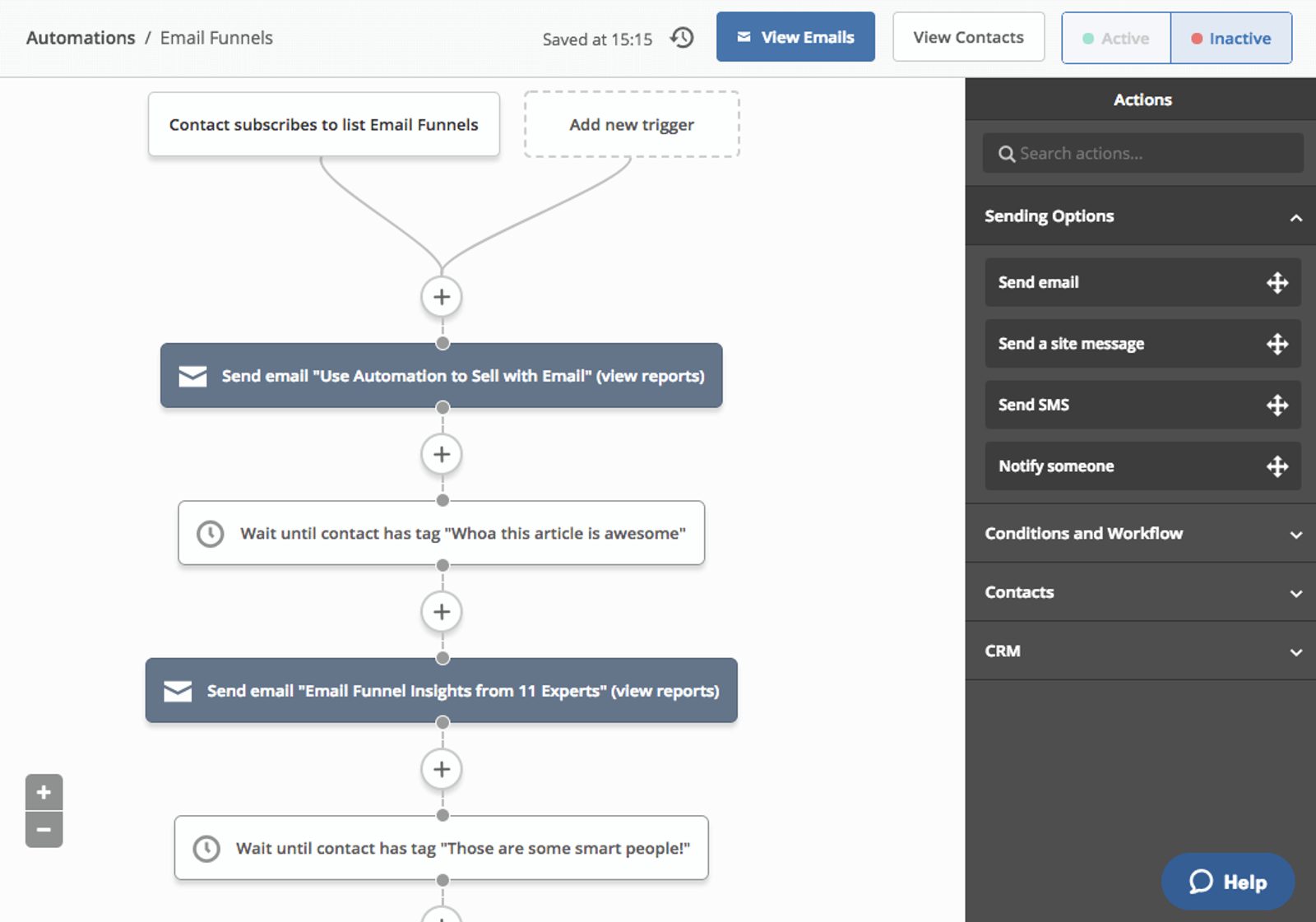
Clearly this is the greatest email funnel of all time
What goes into a great email funnel strategy?
- Understanding the stage of awareness for each of your contacts
- Email segmentation that actually helps you do better marketing
- Personalization and personality that help your message resonate
- Maintaining high-quality lists
- Persuasively driving people to the right calls to action
Let’s start with the most fundamental of fundamentals.
Here’s the best tool to set up email funnels
Stages of awareness:
The most fundamental of fundamentals
In the days long before email, marketers and copywriters had to rely on old-school methods of communication to get their message out there.
Yeah, I’m talkin’ snail mail.
Direct mail is still a huge area of marketing today, but back in the day, it was even bigger. With so few ways to reach individual people, showing up in a literal, physical inbox had value.
Of course, it also had a cost.
Every piece of mail sent had a very real marketing cost. So the people that got good at direct mail needed to get good fast – or waste massive dollars sending out messages that didn’t convert.
Modern copywriters still study the techniques they used. And many of those techniques come to life in email marketing.
Email marketing is sort of like direct mail on a massive scale. It offers similar one-to-one communication but can be sent much faster and at a lower cost. It’s also even easier to test and measure.
So it makes sense to learn from “the old masters.” And none were so masterful as copywriter Eugene Schwartz.

Source: Amazon
Eugene Schwartz’s Breakthrough Advertisingis the copywriter’s bible. If you want to get a copy for under $125 – good luck. The lessons it teaches are so fundamental to great marketing that copywriters consider it a necessary expense.
The most important lesson of all? Stages of awareness.
The concept of stages of awareness is simple – different people have a different level of understanding of their own problem and your ability to provide a solution.
But hiding inside that simple definition is a treasure trove of actionable insights.
Understanding stages of awareness can teach you:
- How long your copy should be
- The number of emails to send in your funnel
- What you need to talk about in your copy
- How to organize your emails to nurture leads instead of just messaging them
We’ll dig into each a bit more. Let’s start by talking about what the 5 stages of awareness actually are:
- Unaware: A person doesn’t know they have a problem, and it’s usually not worth marketing to them.
- Problem Aware: A person knows they have a problem, but doesn’t know there are solutions to that problem.
- Solution Aware: A person knows there are solutions, but hasn’t chosen one and doesn’t know about your product.
- Product Aware: A person knows about your product, but isn’t totally sure it solves their problem.
- Most Aware: A person knows a lot about your product. They are on the cusp of buying, but need to know the specifics.
Knowing the stage of awareness of your prospect tells you how much information you need to give prospects before they’re willing to convert.
Joanna Wiebe, conversion copywriter and founder of Copy Hackers, explains the stages well in this chart.
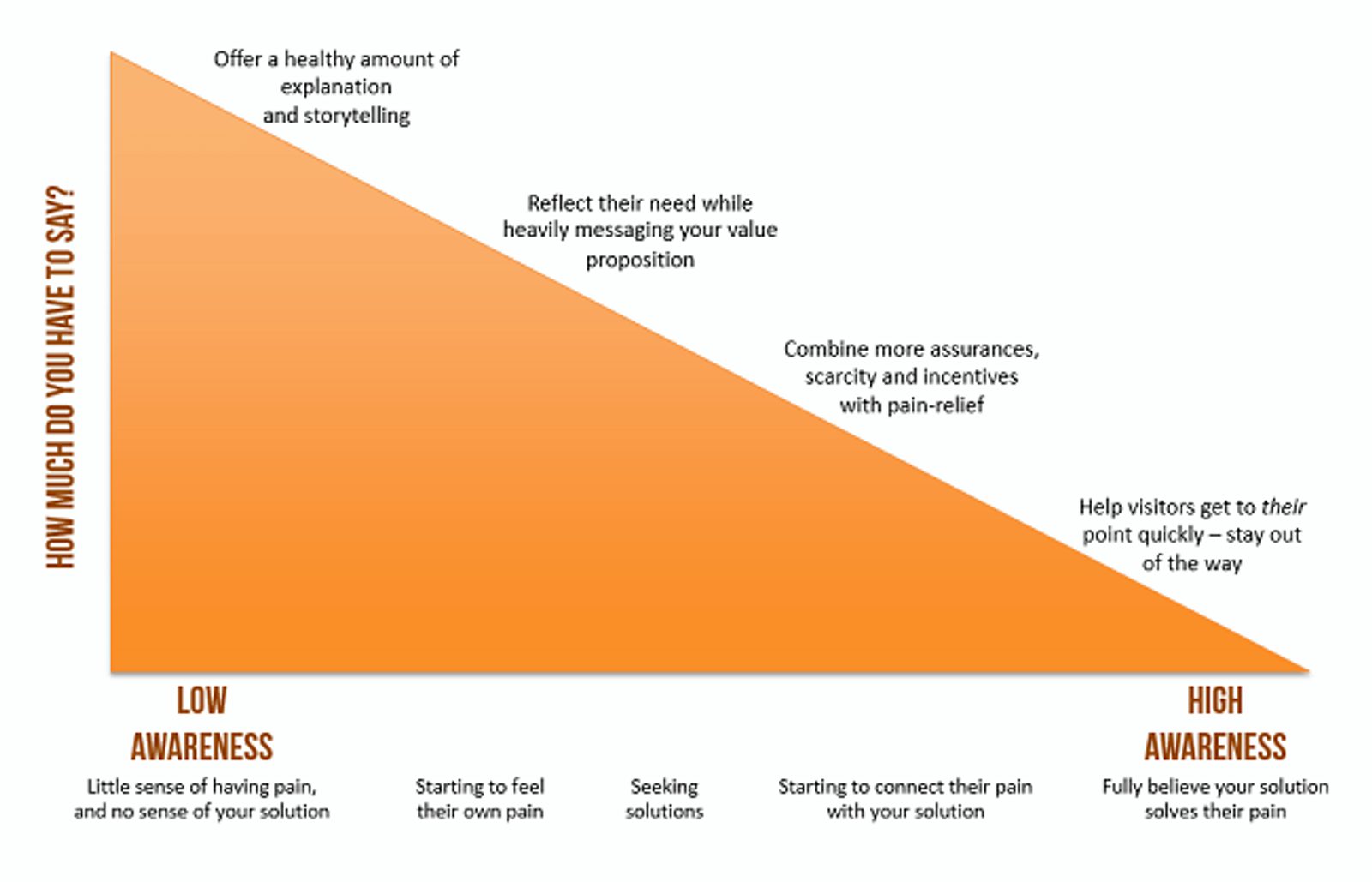
Source: Copy Hackers
Stages awareness is easier to understand with an example, so let’s imagine two people who are both trying to lose weight.
- Mike, a 40-year-old man, was in great shape back in his 20s. But since his career and family started taking up more time, he’s gained some weight. He’s ready to lose it.
- Joe, a 40-year-old man, has been overweight his whole life. When he turned 40, he decided that he wanted to lose weight once and for all.
If you sell an exercise program, how would you need to speak differently to these people?
Mike, our formerly fit friend, knows a good amount about working out. It’s been a while, but he’s been in shape before. He knows the terminology. He has some sense of what works. But he hasn’t heard of you yet, so he’s Solution Aware.
The message you send to Mike would be designed to make him aware of your product, then to get him to think your product is the best solution. The steps of your message might be
“You want to lose weight, so you need an exercise program.
This program combines strength training, healthy diet, and encouragement to get you results.
You can get the program, plus one-on-one training help, for $50 per session.”
If you want to talk to Joe, though, you have to start earlier.
Joe also wants to lose weight, but he’s never been in shape before. He may have a vague sense that exercise is good, but he doesn’t know of any specific workouts – or what he needs to be looking for. Joe is Problem Aware (also called Pain Aware).
“You feel uncomfortable in your own skin. Enough is enough – you’ve decided to lose weight.
If you’re thinking about losing weight, you’re probably looking at exercise routines.
Did you know that exercise can only get you so far? Diet is actually the key to shedding pounds.
When you combine diet with a great strength training program, you train your body to burn fat for energy. It takes energy to build and maintain muscle, and that energy comes from the food you eat. So if you build more muscle and eat less food, you lose weight.
This program combines strength training, healthy diet, and encouragement to get you results.
You can get the program, plus one-on-one training help, for $50 per session.”
Pretty different, right?
Let’s ignore that the copy isn’t very good. Notice the ways that these messages are different (and the same)
- The second message is much longer. Joe is only Pain Aware, so we need to do more work to get him ready to say “yes” to our offer.
- Both messages match the prospect’s stage of awareness. Mike is probably thinking “I need an exercise program,” so that’s what we lead with. Joe is probably thinking “I’m tired of feeling like this,” so that’s what we lead with.
- Both messages work to steadily advance the prospect from their starting stage of awareness to Most Aware
Read that last one again. Both messages work to steadily advance the prospect from their starting stage of awareness to Most Aware.
That is the core insight that can dictate the entire strategy of your email funnel.
When you start with Pain Aware prospects, you need to
- Reflect their pain in your starting emails
- Explain that there are solutions that can solve their problem
- Introduce your solution
- Convince them that your solution is the best answer to their pain
When you start with Product Aware prospects, they’ve already heard of your solution. So instead
- You reflect their stage of awareness by introducing your solution
- You convince them that your solution is the best answer to their pain
If your prospect is Most Aware? All you need to do is make a great offer.
They’re just about ready to buy.
The goal of your email funnel is to move people from their stage of awareness to the point of sale.
This is the most fundamental of email funnel fundamentals. It shapes which types of emails you choose, how frequently you email, how long your funnel needs to be, and what messages you send.
Expert insight: Jordie van Rijn on nurturing leads

“Don’t assume all of your leads need to be warmed up. If you don’t know, you don’t know.
Here is what you do: If appropriate for your product, add a non-sleazy call to action to the end of your email, to give them the opportunity to make a micro-conversion. Let them explore, look at your product, take a next step (or already buy.) Use the 'clicked, but non-converted' on that link to put these in the fast-track in your 'funnel of love.'"
– Jordie van Rijn is email marketing consultant and founder of emailvendorselection.com
Dealing with Pain Aware prospects? You probably need a longer marketing automation funnel.
Dealing with Most Aware prospects? You probably just need to make an offer.
Not sure what stage of awareness prospects are in? Or, are you dealing with a mix of different stages of awareness? Segment (more on this soon), but consider making an offer up-front to make sure you convert those Most Aware prospects into customers.
Segment your email funnels
Not all of your prospects care about the same things. So why would you send them all the same messages?
Segmentation is when you group your larger email list into categories based on the information you have about your contacts.
Segmentation is a major reason that email marketing is so powerful.
With email, you have a massive amount of information that you can use to better understand your audience.
You can track which people open your messages. Which links they click on. Where they are in the world. Demographic information. Purchase history. Visits to your website. The list goes on, and every single factor can be used to create a segment.
When you speak to a narrower group of people, you can address their problems more specifically.
In our earlier example, Mike and Joe needed different fitness messages even though they were both 40-year-old men.
If our imaginary fitness email list also included 23-year-old men and women, and 30-year-old new mothers, each of those demographics would probably deserve their own segment too. Maybe multiple segments.
Not everyone in your audience cares about the same things. Some features are more important to some segments than others. Some segments start in different stages of awareness.
Segmentation lets you send the right people exactly the right message for their needs.
Expert insight: Joel Klettke on personalization

“People treat all of their leads exactly the same – as though they are one big mass of identical people.
But they aren't. They have different roles, goals, preferences, and needs. Learning these early on in an email funnel (using tactics like having a lead click to self-identify or pulling in data from surveys/forms) can make an enormous difference.
Once you know a little bit more about your segments, plan your email funnel to speak to them each differently, in different scenarios.
Where you can, use behavior-based triggers to tailor things even further. And if you can't? Invest time in making your time-based funnel more personal for the people in it.
More work? Sure. Better results? I'd all but guarantee it.”
– Joel Klettke is a conversion copywriter. He is the founder of Business Casual Copywriting and Case Study Buddy.
So segmentation is important. It leads to higher open rates. Clickthroughs. More customers. And you can segment based on almost any criteria – but what criteria should you use to segment your list?

Source: Email Monday
The answer: Segment when it would change the messages you send.
Segment when dealing with groups that have significantly different wants, needs, and concerns.
If you sell B2B, you might segment based on self-reported industry and company size. An ecommerce company with 10 employees probably has different needs from a life science company with 250 employees—so treat them differently.
You can segment based on interest. If you run a health business, is your audience more interested in exercise or nutrition? Build segments for each so that you know what follow-up to send.
You can segment based on behavior. Who’s opening all of your emails? Who clicks all of your links? Who buys from you...then buys again? Your most engaged contacts probably deserve different messages.
How do you get the information to segment people?
- Your contacts can enter information in a form when they opt-in
- You can track contact behavior to see how they engage with your email and website
- You can tag people based on what they say they are interested in
We’ll talk more about segmentation emails later, but here’s a quick example from Peter Nguyen of The Essential Man.
Peter helps young men dress better. But there are a lot of reasons that young professionals could want to dress better. And the messaging he uses could change significantly, depending on the reason each contact has.
Enter his welcome email.
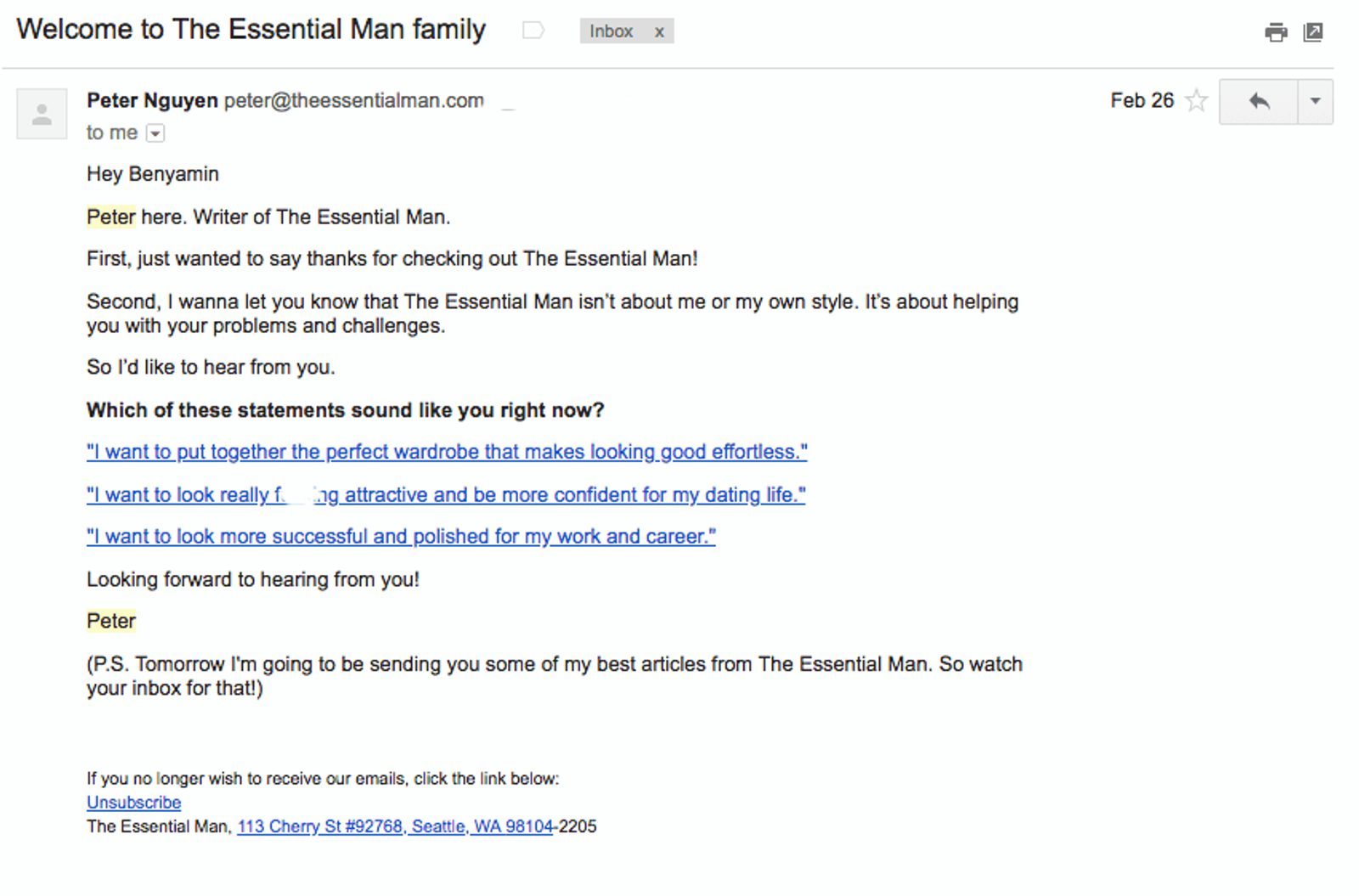
In the welcome email, Peter gives three links with three different purposes.
When a contact clicks on a link, he can add a tag – so he knows exactly what messages to use when he follows up.
Once you have the information you need, the technical side of segmentation is easy.
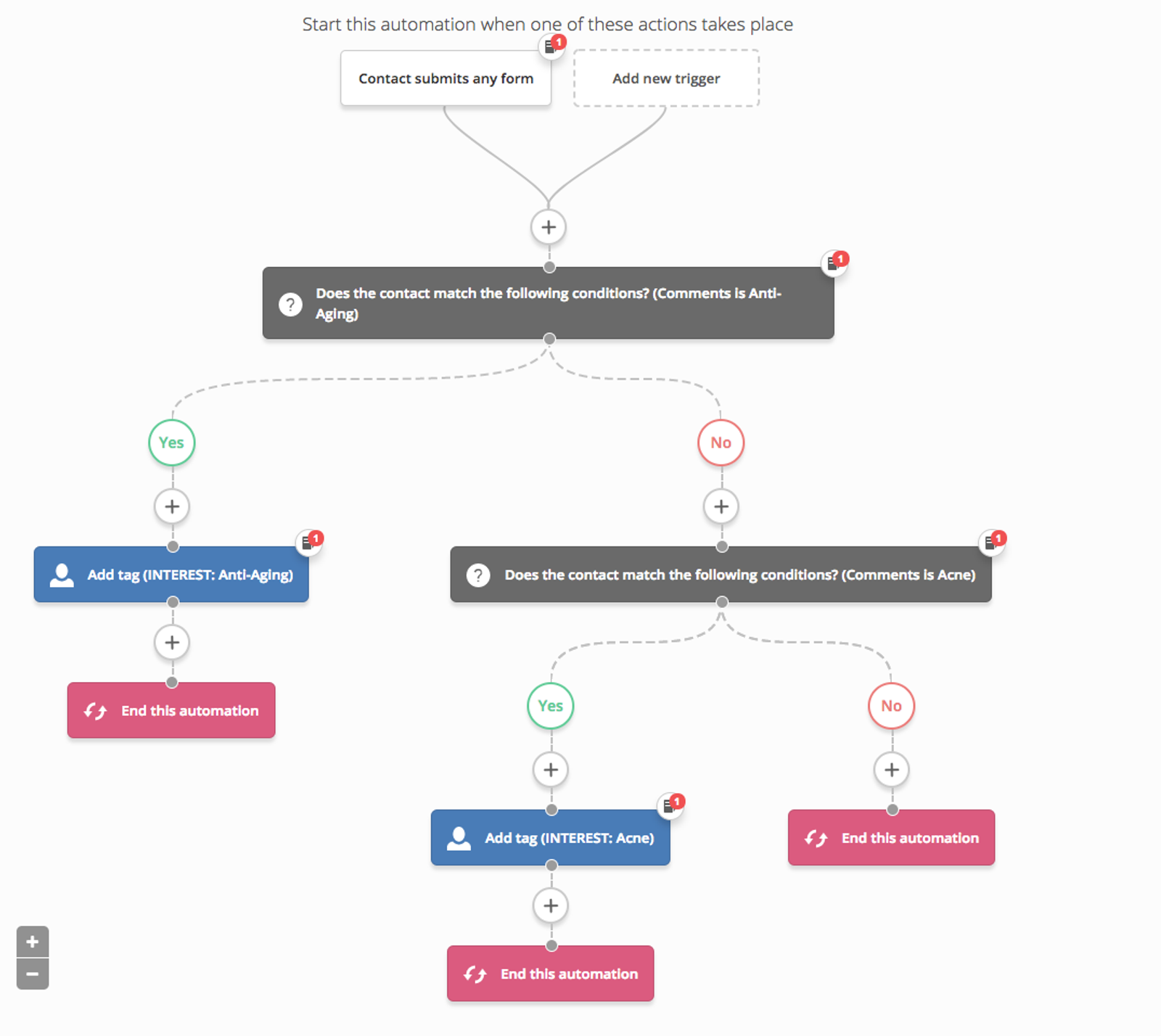
This automation adds a tag to mark leads as interested in acne or aging based on their responses to a quiz.
Once the tag is added, a business like Platinum Skin Care can quickly follow up with another automation.

Because you can trigger automations based on link clicks, email opens, tags, website visits, and all sorts of other start conditions, actually segmenting your list is easy once you have the data.
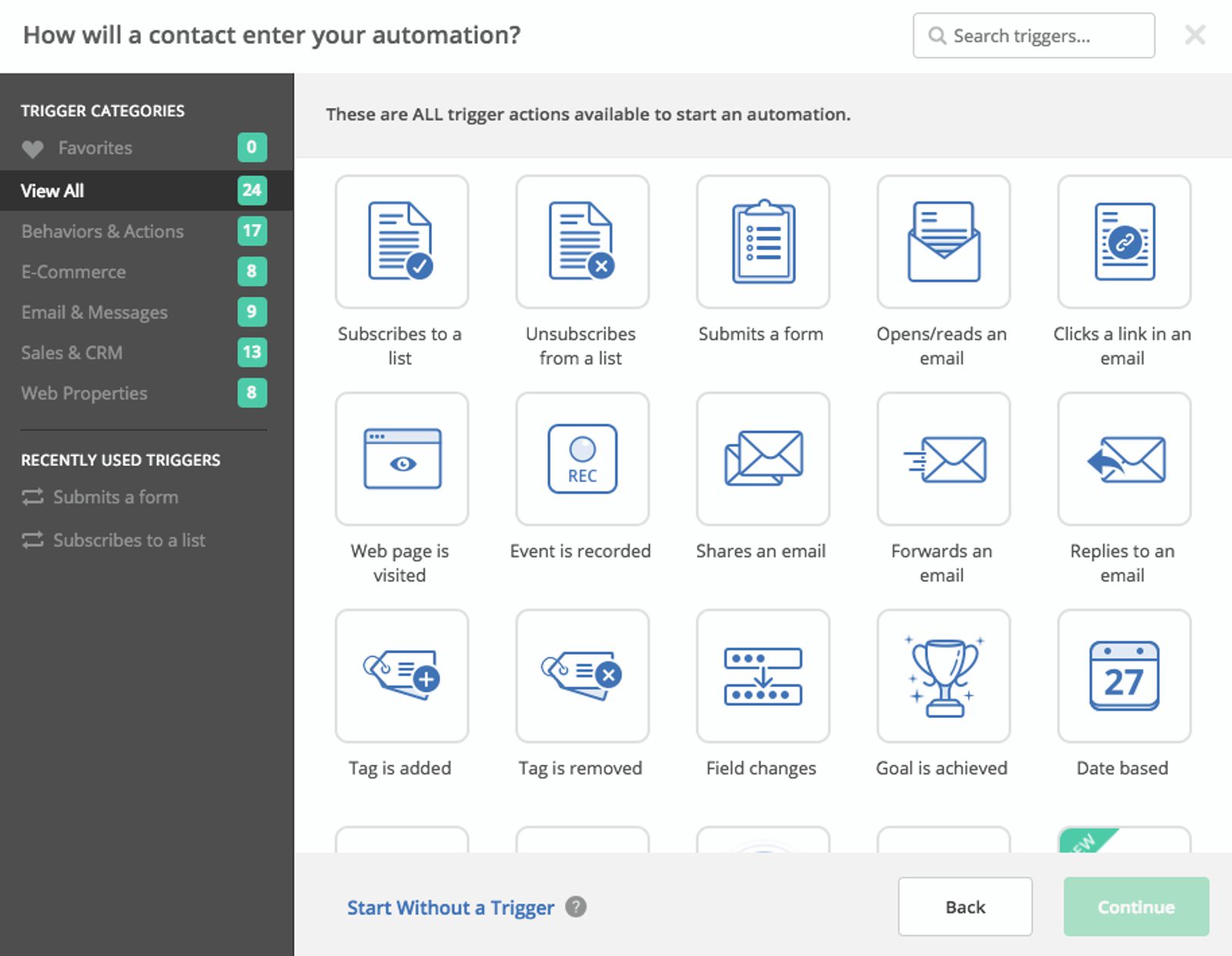
The start triggers available in ActiveCampaign
What if you don’t have the data to segment your list?
First: work on getting that data. Add segmentation emails, update your forms, set up website tracking, and generally try to get more information about the people on your list.
In the meantime, listen to email expert Jordie van Rijn.
Expert insight: Jordie van Rijn on segmentation
“Segmentation is often misunderstood. It is the art of thinking in groups. Groups that when treated differently, lead to better results.
If you aren’t able to segment because data is missing, there are two ways around that.
- First: make the message so it is attractive to all.
- If that fails: go for the popular option (that will appeal to the biggest part of your database).”
Send valuable messages with personality
Why should anyone read your emails?
It’s true, you have great things to offer. You have an offer that promises to solve your audience’s needs if only they’d take the time to look at it.
It’s also true that people want to hear from you. People want to hear from the brands they follow. And right after they opt-in, a new contact is extremely likely to read your welcome email.
But you need them to keep reading.
When you set up an email funnel, it isn’t enough for people to need what you offer. It also isn’t enough to logically step through all of your offers features and benefits one at a time.
Because that’s boring.
You need to do more than show your product. You need to sell it.
To do that, you need to infuse your emails with value and personality.
Expert Insight: Laura Belgray on personality

“I think most people go for ‘proven’ email templates and swipe copy, while overlooking the value of injecting their unique personality and stories.
It’s important to remember that if your subscriber sees you as yet another marketer, they’ll take any excuse they can to ruthlessly hit ‘delete’ and clear you from their inbox.
If they see you as a person — a person they’ve come to know, like and trust — they’ll be way more inclined to read your email all the way through, and maybe follow your call to action.
That’s what adding personality achieves: it builds a connection so that instead of, ‘ugh, another email from someone selling something’ it’s, ‘Yay, an email from [insert your name here].’”
– Laura Belgray is a copywriter and founder of Talking Shrimp. You can learn how to write high-converting emails with her guide to subject-line writing.
Why is personality an essential part of your email copy?
- Your readers don’t feel like they're being sold to (which no one likes)
- It makes your messages more distinctive and memorable
- You sound like a real person, which builds trust
No one likes feeling like a column in a P&L statement.
People want to know that you are a person that cares about them. That your eyes don’t turn into big, green dollar signs when you look at them.
Personality makes you more relatable. It makes you seem like a real person—and it’s much, much easier to trust a real person than it is to build a relationship with a faceless brand.
Personality also makes it easier to add emotion to your emails. Humor. Anger. Frustration. Confusion. The big emotional levers that ultimately convince people to buy.
Have you ever seen an angry table? A sad chalkboard? A perplexed podium?
No. Because it’s hard to attach emotion to objects and abstract concepts (like companies). It’s much easier to do when there’s a person — who has a personality — in the mix.
As copywriter, Robert Collier said in The Robert Collier Letter Book:
“Appeal to the reason, by all means. Give people a logical excuse for buying that they can tell to their friends and use to salve their own consciences. But if you want to sell goods, if you want action of any kind, base your real urge upon some primary emotion!”
On a more scientific level, emotion is memorable. And when people remember you, it’s much easier to talk to them. And sell to them. And get repeat business.
Elizabeth Phelps, a professor at New York University, said it well in a paper reviewing the research on human emotion and memory,
“there is abundant evidence that memories for emotional events have a persistence and vividness that other memories seem to lack.”
So how can you build trust and emotion in your emails?
Step one is to add value.
At the core of every email you send, there needs to be a big idea. And that idea needs to answer the question that’s always running through the reader’s mind: “How is this going to help me?”
Even in an email funnel designed to get sales, slipping value-adds into your emails is going to improve their performance. Focus on adding value first and you activate the psychological norm of reciprocity – people help people who help them.
Expert insight: Joanna Wiebe on value

“The recurring insight I see marketers and copywriters overlook when crafting an email funnel is this: people read emails when there's value in those emails.
For some reason, there's this prevailing myth in email marketing that you have to 'keep it short' and 'send fewer emails' to 'avoid irritating people.' And while I know for certain that a succinct email in a tightly planned funnel is a good thing, I have never once seen evidence that you need to keep anything valuable short or that you should only send a few valuable emails.
So marketers would be wiser to plan their funnels – and the emails in them – around delivering incredible value.
Forget about short vs long. Forget about frequency. Forget about the number of emails to send.
Start with the value you're going to provide, and make that value so incredible people would pay for it. Then see if your funnel isn't 10x better than back in the days when all you worried about was whether you were using too many emails or too many words in those emails.”
– Joanna Wiebe is the original conversion copywriter. She is the founder of Copy Hackers and Airstory.
Step two? Sound like a person.
How many websites have you seen that sound like this:
“We bring together a variety of best-of-breed, cutting-edge solutions to optimize your performance and grow your business.”
What?
I’m exaggerating—but only a little. Too often, businesses forget that they are talking to people (even in B2B, you still talk to people within businesses).
No one has ever woken up in the morning and thought “Man, I could really use some best-of-breed solutions.”
No one has ever called up a friend for advice and said “I need help leveraging my existing capabilities to optimize my workflow” (they might say “I’ve been feeling so unmotivated lately.”)
Choose simple words. Words that someone might use hanging out in a bar with their friends. Simple words can still express complicated ideas. They’ll just do it more memorably.
Did you know that the US government literally had to put together a website to get people to use simpler language?
It’s run by (no joke) the Plain Language Action and Information Network.
Aka...PLAIN. You can see their very helpful guidelines at plainlanguage.gov.
Here are the “dirty dozen” words they list – a dozen words, phrases, and expressions that need to be made simpler.

It’s hard to talk about personality, adding value, and email funnels without mentioning Ramit Sethi of IWT and GrowthLab.
The IWT and GrowthLab newsletters are renowned for their content. Ramit is unlike many email marketers in that his emails often blur the lines between copy and content—even if you don’t decide to buy an IWT product, you’ve likely learned something by going through the funnel.
Curious about how to write engaging emails that add value and have personality with simple language? You can actually watch Ramit Sethi in action. He recorded a video that lets you peek over the shoulder of one of the best email marketers in the business as he writes one of his famous “engagement emails.”
Expert insight: Talia Wolf on customer focus

“Most emails are written with business goals in mind, not people.
As marketers we know what our goals are and what we want to achieve and that's how we write our emails, with our clear intention of converting 'subscribers' or 'our list' into customers.
It's easy for us to segment our readers according to the data in front of us, the actions they've taken, how long they've been on your list, their geographical location and other behavioral segments.
However, people read email, not data, not numbers and not graphs.
Unfortunately we forget there's people behind those screens and people will only read your emails if they correlate with their goals and solve their problems.
You can have all the tools in the world, machine learning, automation, AI and what not, but at the end of the day someone still needs to write those emails and get people to open them up and convert. If you want to do that you need to understand your customers better, their goals, their concerns, their pain and needs.
Only then will you be able to write emails people will want to convert to.”
– Talia Wolf is a conversion optimization expert and founder of GetUplift. For more on high-converting funnels, you can read her guide on emails that convert.
Are you talking to the right people?
Segmentation is a huge factor in making sure that you talk to the right people. But if you start off with a low-quality list, all the segmentation in the world isn’t going to help.
There are two ways to end up with a low-quality list:
- You attracted the wrong people to your list
- You let the people on your list get disengaged
Note: You may hear some people talk about buying lists. We never recommend buying an email list. Not only is this against our terms of service – it creates a negative experience for readers and is probably a waste of your money anyway.
How do you wind up with a list of people not interested in what you have to say? Usually, you would expect people who opted in to hear from you to...want to hear from you. Right?
Low-quality lists tend to happen when one or more of a few things are true:
- You create content that is relevant to a broad audience – but you only sell products for a specific audience
- You create content that isn’t related to your core product offering, so you attract the wrong subscribers
- Your opt-in copy and lead magnets don’t clearly present what you stand for as a business
When people subscribe to your email list, they should know what to expect – the messaging you have across your website needs to accurately represent the value you give your subscribers.
Misrepresenting or poorly communicating what you do is the easiest way to wind up with a low-quality email list.
If you serve a niche audience, it’s not all that uncommon to attract subscribers from outside your core customer base. This isn’t always a problem – these people may still be interested in reading and sharing your content, even if they are unlikely to buy. But you’ll probably want to create a separate segment of people outside your core audience.
Most of the time, your list quality improves when you create compelling content and have accurate, interesting messaging on your website. As long as there’s someone on your list that’s even vaguely interested in becoming a customer, you can create a segment for them.
But what if your leads have gone cold?
Expert insight: Margo Aaron on long-term engagement

“Readership! We glorify the 'opt-in' as being the qualified leads Mecca. Your list is filled with people who want to hear from you ahhh!!! YES $$$$$$$.
But it's not true.
Yes, they opted in. And when they opted in they wanted to hear from you (keyword: wantED) (past tense). But they meant it in the same way you meant it when you said "Hey would should have dinner sometime!" to that couple you ran into and then when they actually follow up with you, you're like 'ughhhhh why did I say that?? I'd rather be home with a bottle of wine in my sweatpants.'
You meant it when you said it, but then reality happened and your affection waned and now you're not really that interested.
So here's what people overlook: Just because someone opted in, doesn't mean they're still interested in you, care about your offer, or want to hear more from you. (Sadly)
You have to earn it. Week after week. Email after email. You have to earn your way into their inbox (to keep the privilege of being read).
You ALWAYS need to be making a compelling case as to why your readers should care. You cannot assume that just because they opted in, they still care about you or your offer.”
– Margo Aaron started her career as a psychology researcher, then transitioned to become a digital marketing and copywriting expert. She writes at That Seems Important.
If you don’t consistently engage with your list, it’s going to be harder to convert contacts in your email funnel.
How you engage with your list is up to you. You could send weekly, bi-weekly, or monthly newsletters that point people to your content. Or, like Ramit Sethi, you could send “engagement” emails that aren’t attached to a clear CTA.
The power of keeping in touch is that it keeps you top of mind. If your content is good, it builds trust. Email marketing is a powerful method of one-to-one communication, but it doesn’t exist in a vacuum – every interaction someone has with your brand affects the performance of your funnel.
A stronger brand relationship means more trust. Which means more conversions.
What if you haven’t been emailing your contacts?
After an email lull, a lot of people send an email that begins with something like “Why I’ve been away” or “Sorry it’s been so long.”
This is actually a mistake.
Outside of superfans (who will just be glad to hear from you), most of your contacts have probably not noticed how long it’s been since your last email.
And they won’t – unless you explicitly call attention to it.
If you haven’t sent emails to your list in a while, just start. If you haven’t been sending to your list at all, just start. You don’t need to make a big announcement – if people are on your list, they want to hear from you.
And if they unsubscribe because you send them more emails? They probably wouldn’t have become customers anyway. So congrats! Your list quality just improved.
Craft a persuasive call to action
This is it.
This is your moment.
The moment your funnel has been building towards.
As you near the end of your funnel, you’ll need to include a persuasive call to action. What is the core offer of your funnel? What is the ultimate goal you’re trying to achieve?
This is the last element of your funnel that a prospect will see, but it may actually be the first one you should put together.
Expert insight: Sophia Le on starting with your offer

“My clients get too caught up in the automation details and end forgetting about the customer.
The customer doesn't care about what segment they belong to or what order of emails they get, they care about whether what you're selling or offering is going to improve their lives. It's why before you start planning any email funnel or automation, you start backwards. Determine the offer – and then back out the various pieces you need to support that offer.”
– Sophia Le helps SaaS companies grow their customer relationships with email. You can get her fill-in-the-blank email templates on her website.
At the end of your funnel, you need to have two things
- A single call to action that asks prospects to achieve your goal
- Persuasive copy and design that sells your call to action
As Sophia says, it’s important to start with your offer. What exactly is the offer you’re making prospects, and where should you drive them to complete that offer?
The answer depends on your industry, but here are a few quick examples.
- Businesses that sell information products often push readers to long-form sales pages
- Ecommerce businesses send people to product pages or directly to checkout
- Service businesses send prospects to contact pages or RFP pages
- SaaS businesses sent to a free trial, a demo with a sales rep, or checkout
Which option you choose depends on your business—both the industry and the type/size of your offer. You don’t need to send readers to a long-form sales page to sell $5 toothpaste, but you might want one to sell a $150 electric toothbrush.
No matter your specific CTA, this next piece is critical: use one call to action.
Don’t ask people to make choices. Making choices takes energy. The more work someone has to do to accept your offer, the less likely they are to convert. (Tweet this)
If you want to sell both toothpaste and a toothbrush, either bundle them or send separate emails.
One email, one call to action.
Limiting yourself to a single call to action already makes your email much more persuasive. How can you persuade people to click your call to action and accept your offer?
Fundamentally, there are two kinds of persuasion:
- Helping people get closer to your offer
- Removing obstacles that prevent people from accepting your offer
Helping people get closer to your offer is what most people think of when they think of persuasion. If you’ve read Robert Cialdini’s classic book Influence, adding his six elements of persuasion is one way to help people say yes.
It’s worth reading the full text – it’s a marketing and psychology classic – but here are the summarized versions of each factor.
- Reciprocity: People are more likely to help those who have helped them in the past
- Commitment/Consistency: People are likely to act in ways consistent with their previous behavior—whether those courses of action still make sense or not
- Authority: People are more willing to believe and trust experts and authoritative figures
- Social proof: People are more easily persuaded to a position when they can see that those around them believe that position
- Scarcity: People are more attracted to opportunities that seem rare or exclusive
- Liking: People are more likely to be persuaded by those they like
In his follow-up book Pre-Suasion, Cialdini added a 7th factor. Unity: People are more easily persuaded by people like them.
Of course, there are other persuasion factors beyond what Cialdini covers.
For example
- Future pacing: Painting a specific picture of how your prospect’s life will improve after taking your offer
- Loss aversion: Phrasing messages in terms of what prospects will lose by not accepting your offer
- Clear, specific value propositions: Being crystal clear about the specific benefits of your offer (surprisingly, these are often missing)
You can find a list of persuasion tactics, with varying levels of effectiveness and spamminess, in simple Google searches (of course, we also recommend using persuasion ethically).
It’s harder to find the tactics that persuade from the other direction. The tactics that, instead of pushing prospects towards your target, remove the factors that stop people from saying “yes.”
Friction reducers.
Pretend for a moment that you’re skating on a frozen lake. You glide easily across the icy surface, and it takes only a small push to get you moving.

Weeeee.....
Now, replace the frozen lake with a concrete parking lot.
You won’t make it very far.
The goal of friction reducers is to make accepting your offer more like skating on ice and less like skating on concrete.
Systematically, you remove the bumps and objections of your prospects, until saying “yes” takes only a small push—your call to action.
How do you reduce friction? Remove doubts.
Anyone who has ever bought anything has gone through the doubting process. Do I really need this? Is it worth the money? Is it actually going to solve my problem?
Your email funnel needs to remove doubts one at a time.
The specific doubts you need to tackle depend on your products. But there are also a lot of doubts that are common across industries and products.
You’ll need to do customer research to figure out which doubts you need to address. But here are a few to get you started.
- “I’m worried this isn’t going to be worth the money”
- “This doesn’t work for people like me”
- “This problem isn’t my fault, so it’s not up to me to fix it”
- “What if I try this and it doesn’t work?”
- “I can always do this later”
“I’m worried this isn’t going to be worth the money.” This objection is more common for more expensive products. To tackle it, reframe the conversations. Talk about the value your offer provides instead of what it costs.
“This doesn’t work for people like me.” Sometimes people believe they are more unique and special than they are. To tackle this belief, call it out explicitly. Also, use social proof from people like them to show that your product does work.
“This problem isn’t my fault, so it’s not up to me to fix it.” Oof. This is a toughie. When people don’t believe they are in control, it can be hard to get them to take action. To tackle it, show your prospect that something is in their control—even if their situation isn’t ultimately their fault. Then show how your offer helps them take control.
“What if I try this and it doesn’t work?” Very common. Very addressable. Use success stories to convince people that it will work, and a guarantee to eliminate the risk of trying it.
“I can always do this later.” The conversion killer! There’s always tomorrow, right? If your prospect believes this, why would they take your offer today?
You can use scarcity and urgency to take away the option of tomorrow. But beyond that, paint your prospect a picture of why it’s so important to start today. Show them what they are missing out on if they delay taking your offer.
Again—you’ll need to address the doubts of your specific audience. But these doubts and objections are a good place to start looking at how you can reduce friction and create an effortless glide to the point of sale.
5 types of email to include in your funnel
When you understand the stages of awareness, segmentation, personality, and persuasion, it gets a lot easier to put together a comprehensive email funnel that sells.
But what emails should you actually send?
There are as many possible emails as there are email funnels, but some email themes repeat themselves over time.
Here are a few types of emails you might consider using as part of your email funnel.
The segmentation email
What if you don’t know anything about your contacts? It will be hard to segment them.
We covered this briefly in the segmentation section, but sometimes you can get all the information you need by sending a quick email to your list.
Here are a couple of other examples of fun segmentation emails.

Val Geisler and The Lost Jewels of Nabooti
Copywriter Val Geisler uses this very humorous email about an old Choose Your Own Adventure book to divide her audience into people at tech companies and online businesses.
This is an example of segmenting an audience by category or industry.
As we saw earlier, Peter Nguyen of The Essential Man uses a segmentation email to see what kind of content will be most helpful.
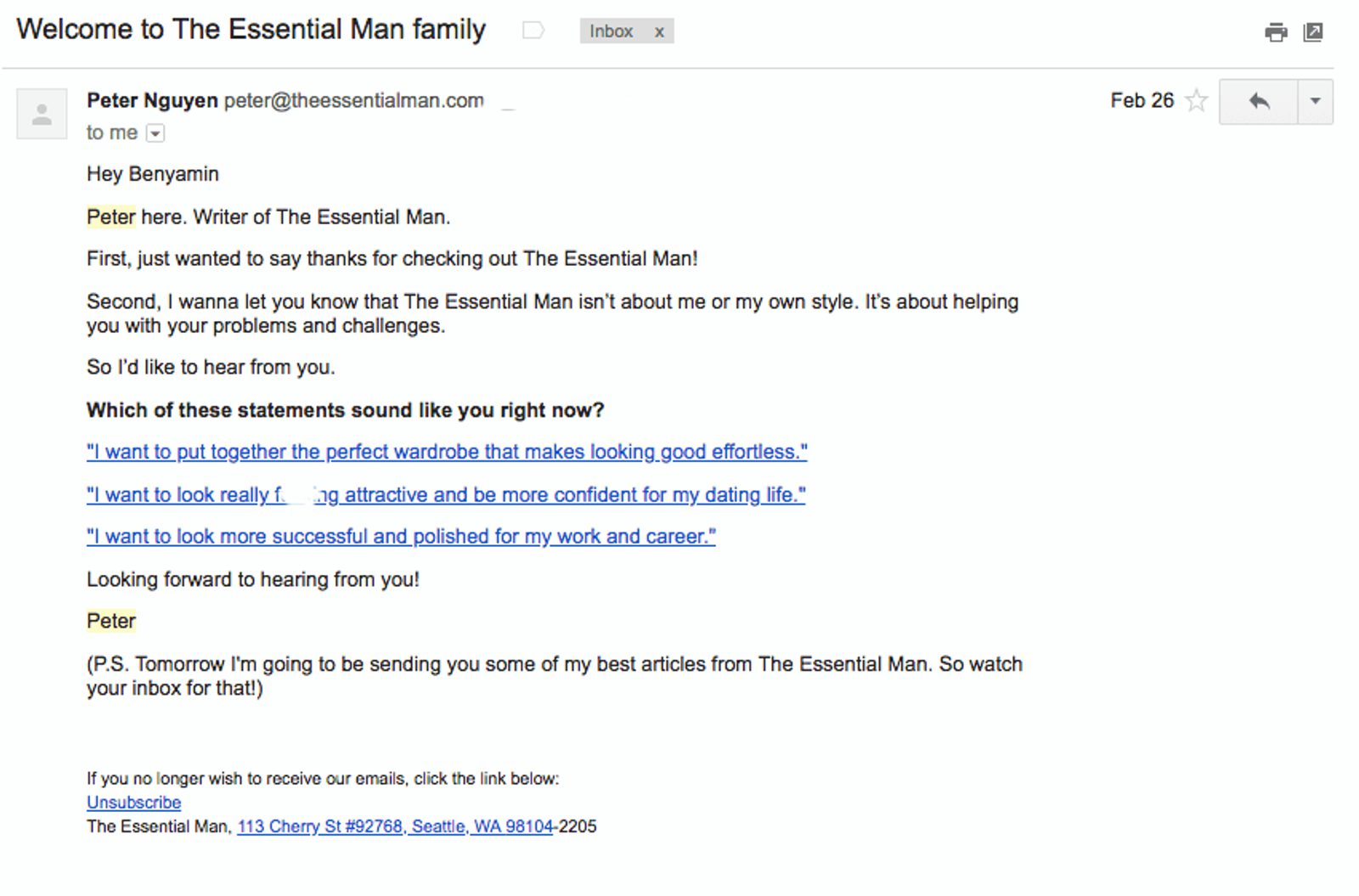
Peter’s audience is young and male, which he knows. So instead of segmenting based on demographics or category, he segments based on interest.
You can segment based on just about any criteria you like. If you serve multiple audiences or offer multiple products, use a segmentation email to see who’s who.
Urgency emails
Would you rather get $20 or avoid losing $20?
If you’re like most people, you want to hold on to your hard-earned cash. This is the core idea behind loss aversion – humans want to avoid losses more than they want to get an equivalent gain.
Combined with urgency and scarcity, this can be a powerful tool for your email marketing.
We’ve all seen urgency marketing. “But hurry! This offer disappears in 2 days!”
Urgency is a great driver of action because it tackles the belief that “I can always do this tomorrow.” When you introduce an element of urgency (or scarcity, e.g. “only 10 tickets available”) you take away tomorrow.
Whether you use urgency or scarcity, you’re also activating loss aversion.
The implied message is “act now or lose this opportunity forever.”
If you use them well, loss aversion and urgency are powerful persuasive drivers that you can use in an email sequence.
This example is an abandoned cart email from Sumo, but check out how they cleverly frame the benefits of their product to activate loss aversion.
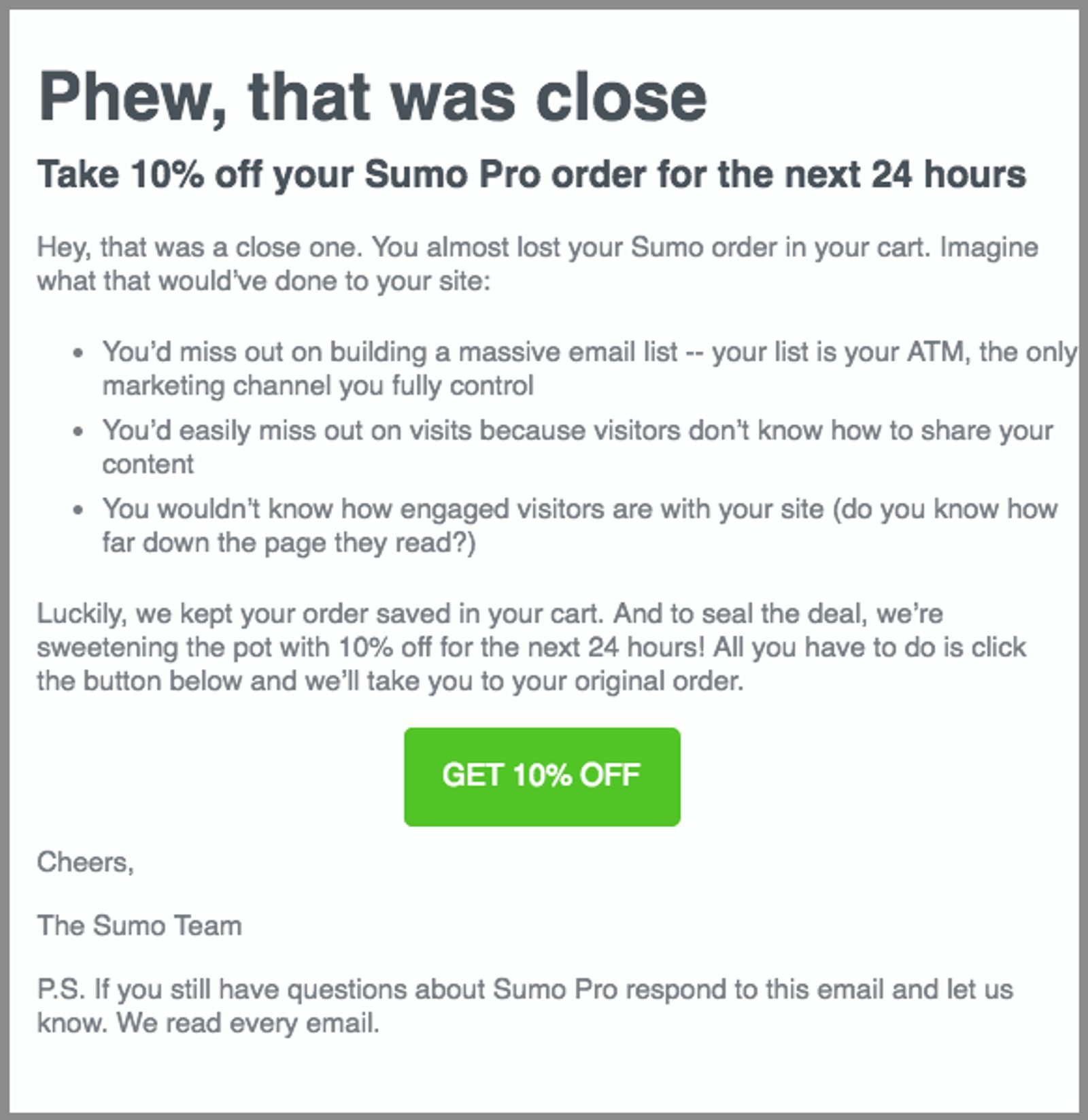
Source: Sumo via Copy Hackers
You’ve probably seen similar messages in email funnels before. Sumo’s email is unusually good, but there are a lot of “your trial is about to expire” and “last chance to save 25%” emails out there.
Check out this email, the last email in Ramit Sethi’s automation (triggered by subscribing to his email list) for his course Zero to Launch.
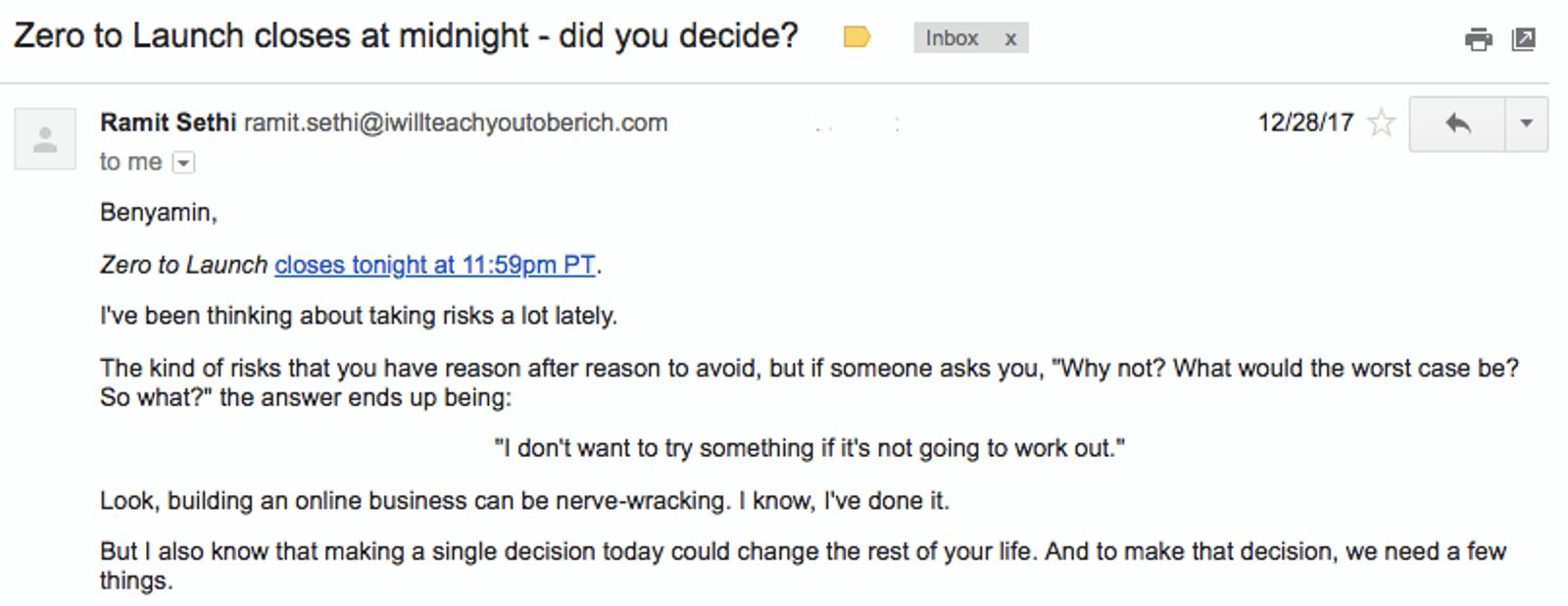
As a nerdy marketer, I think this email is hilarious – because it tries to counteract loss aversion at the same time as it activates loss aversion!
On the one hand, Sethi creates a sense of urgency. His course closes at midnight. On the other hand, he has to fight loss aversion by minimizing the risks and downsides of trying out his course. The result is a very compelling final email.
If you’re thinking about using urgency, scarcity, and loss aversion – be careful. Marketers and beginning copywriters often over-rely on these factors because they are easy to use and understand, as well as being extremely powerful.
But there are downsides.
Expert insight: Jordie van Rijn on scarcity
“Any kind of “Booster” like scarcity or discounts only work if there is an interest in the product to begin with. No use dangling a carrot if your lead doesn’t want a carrot.”
You can’t use urgency to sell a product no one wants. You can’t use scarcity or loss aversion to make up for not clearly communicating your value proposition.
In her book May I Have Your Attention Please, copywriter Mish Slade makes a great point:
“A big reason so many businesses compete on price is because they can’t prove what value they offer, so they’re stuck with the one selling point that’s a breeze to communicate: cheapness.”
Discounts are easy. Urgency is easy. That doesn’t mean you can neglect the other elements of your funnel.
As a final warning – loss aversion is fatiguing. If you bombard your subscribers with loss aversion/urgency emails, you’re going to tire them out and negatively affect your brand.
Think about it: thinking about losing things is a negative experience. Why would you keep interacting with a brand if it only ever gives you negative experiences?
Use loss aversion and urgency strategically in your messages. Avoid overuse, and you’ll find that they make powerfully persuasive emails.
Why this will work for you
“You are my friend
You are special
You are my friend
You're special to me.”
These are the opening lyrics to the song You Are Special, by none other than Fred Rogers.
Though it may be true that everyone is special in their own way, your prospects have a tendency to believe that they are special in ways that don’t matter – at least insofar as it affects their ability to get value from your products.
When you sell...just about anything...prospects start to throw up objections in their heads. One of the most common is “This won’t work for people like me.”
In fitness, it’s “This doesn’t work for people with my genetics” or “This won’t work for people who can’t spend hours at the gym.”
In business, “This only works for businesses that have [insert number of people, technology, obscure resource].”
It’s common for people to think that they are the exception. Sure, the product you offer them is great – for other people. You need to show them that, although they are surely unique, your offer applies to them too.
That’s what this email is for.
There are a few ways to approach a “why this will work for you” email.
- Share data on the average results of your users
- Explicitly say that this works even for special cases
- Include case studies and testimonials from people like your prospect
Of these three, the final one is the most common. Case studies and social proof are certainly powerful – take a look at a snippet from another Ramit Sethi email (for a course on copywriting)
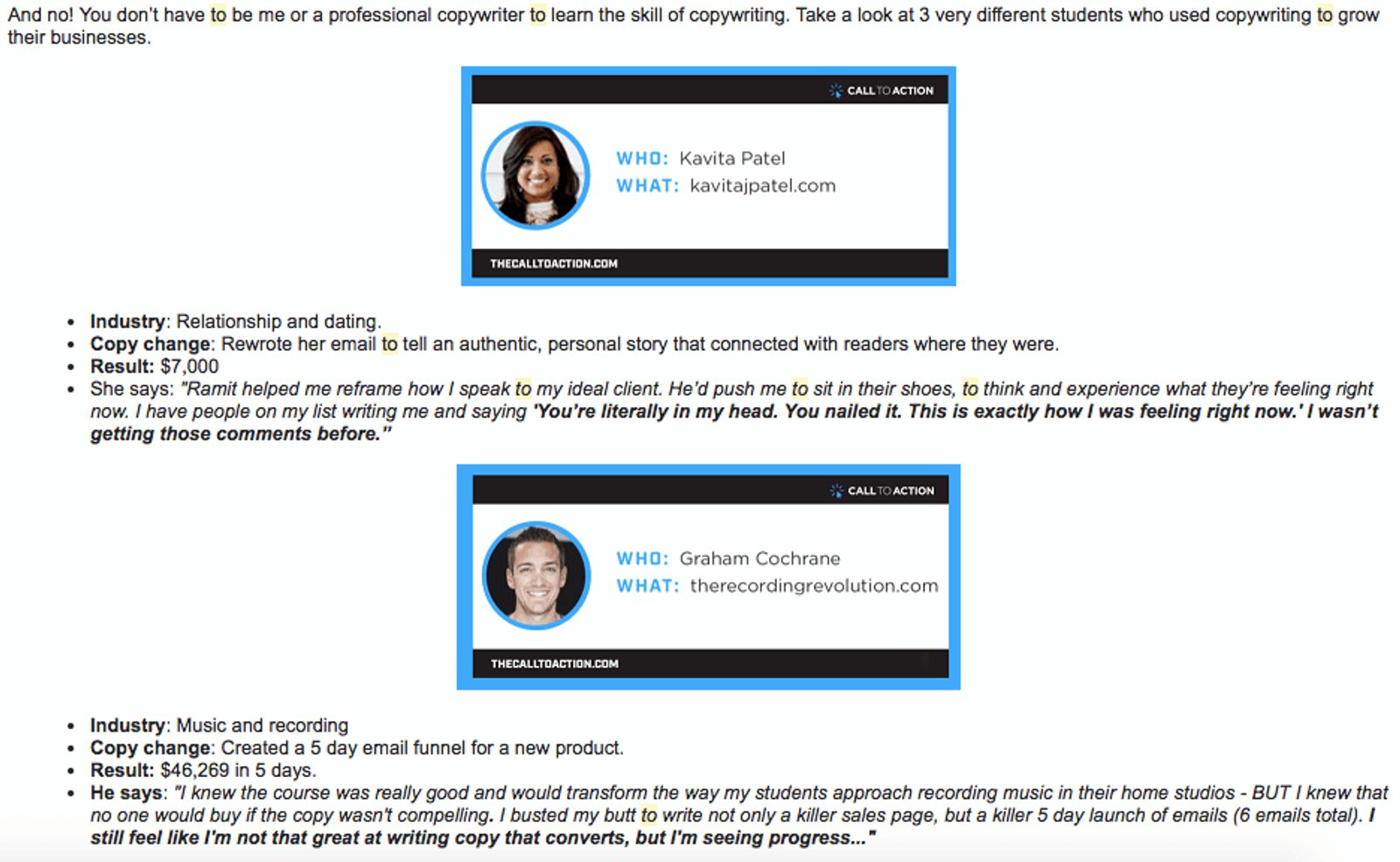
This course is aimed specifically at online business owners – not people trying to become professional copywriters. Hearing success stories from other business owners is compelling, and overcomes the fear of “not being a copywriter.”
Explicitly calling out the “special case” beliefs is powerful as well. You can even use a quick copywriting trick – “even if” sentences.
Check out this quick example of a fictional fitness product.
“Body Blaster Blueprint will help you lose 10 pounds in a month – even if you have crappy genetics, don’t know what to do, and don’t have hours to spend at the gym.”
Take away the “even if,” and that copy gets a whole lot worse. “Even if” sentences are a great way to subtly head off common objections.
A final note of warning: case studies are powerful, but that doesn’t mean you should always use them. Social proof can be a strong persuasion tool, but it doesn’t work alone.
Use social proof when you need to:
- Add credibility to a value proposition or claim
- Make a statement that would sound less convincing coming from you
- Prove that your offer gets results for a niche audience
Don’t just throw in social proof for the sake of social proof. It isn’t always the best way to make your point.
Good Will Hunting emails (“It’s not your fault”)
In 1998, Robin Williams won the Academy Award for Best Supporting Actor for his performance in Good Will Hunting.
There are many magnificent moments in his performance, but one of the most memorable is the “it’s not your fault” scene. Will (Matt Damon) breaks down in tears. “It’s not your fault” becomes a pivotal moment in the film.
Outside of outstanding cinema, “it’s not your fault” is a powerful sentiment to use in your email funnels.
I can’t make this point any better than Blair Warren did in The One Sentence Persuasion Course:
“The very fact that it is okay for us to feel a certain way encourages us to stop fighting to maintain and justify our feeling that way. When we’re told it is okay to dream, we tend to be more flexible with our dreams. When we’re told we’re not responsible for something, we often find that we’re more open to accepting responsibility for it. When we’re told that it’s okay to be afraid, we often feel less afraid.”
When you send an “it’s not your fault” email, you get to play the role of Robin Williams to your prospect’s Matt Damon.
It’s hard to find good examples of “it’s not your fault” emails – they’re relatively underused in email funnels. Here’s a fun example that Ramit Sethi uses in one of his long-form sales pages.
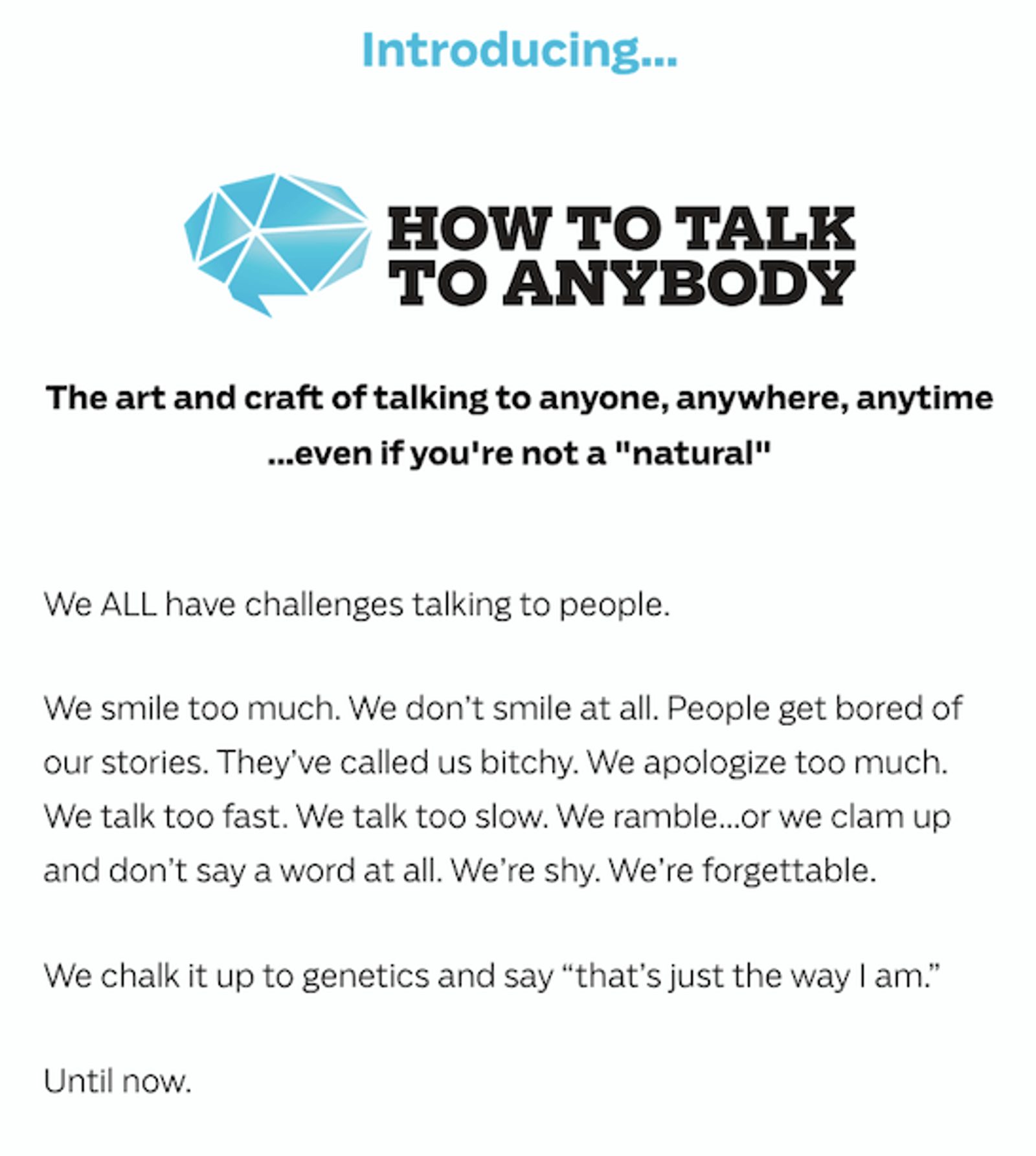
Source: IWT
The gist of this message? It’s ok if you’re not good at this right now. You can get better.
“It’s not your fault” instantly takes the pressure and guilt off the prospect. It kills what email copywriter Ry Schwartz calls “Sacred Cows” – self-limiting beliefs that your prospects have but don’t want to have.
People love being told that their shortcomings aren’t their fault – and a lot of the time there are very valid external forces to point the finger at.
When you point that finger for them, they relax. They feel better. They become more receptive to what you have to say.
Future pacing email
“Here’s the only thing you’re selling, no matter what business you’re in and what you ship: you’re selling your prospects a better version of themselves.” – Joanna Wiebe
This insight isn’t the foundation of great sales. It goes deeper than that. This is the bedrock, the stone that supports every other aspect of your sales and marketing.
This insight is where ideas like “sell benefits, not features” come from. It’s a simple idea – but when you apply it well it can transform your entire business.
That’s where future pacing comes in.
Let’s take our fictional fitness product, Body Blaster Blueprint, and look at what some future pacing might look like.
“Imagine waking up tomorrow and knowing exactly what to do for your morning workout.
You don’t have to wonder what exercises get results, or worry about hurting yourself with bad form. You have an exact, step by step program – complete with instructional videos – that handles everything for you.
But [name], I want you to think beyond tomorrow morning too.
What would your life be like if you woke up in two months and finally fit into your old jeans? If you could carry groceries without sweating through your shirt?
6 months from now, imagine your college reunion. And surprising all the people that remember you as 'the chubby guy.'
In a year, picture yourself looking in the mirror and seeing a body that you’re proud of.
I want that for you. All of it. And it doesn’t need to be hard, or take long hours at the gym.
Body Blaster Blueprint is a step-by-step program that teaches you to lose weight and keep it off. So you can live an active life. So you can still indulge from time to time. So you can feel comfortable in your own skin and live the life you really want to."
If Body Blaster Blueprint were a real product, I’d probably want to take another look at this copy.
But you can see the future pacing. I start with a very immediate benefit – knowing what to do in your next workout. Then I push harder – 2 months, 6 months, a year from now, how could your life be different?
Future pacing usually starts with short-term benefits, then paints a picture of how a prospect’s life could improve. It’s power is in phrases like “imagine” and “picture yourself.”
To quote copywriter Robert Collier in The Robert Collier Letter Book:
“The mind thinks in pictures, you know. One good illustration is worth a thousand words. But one clear picture built up in the reader’s mind by your words is worth a thousand drawings, for the reader colors that picture with his own imagination, which is more potent than all the brushes of all the world’s artists.”
A future-pacing email helps your prospects paint a powerful picture
Why didn’t you buy?
You’ve reached the end of your funnel. Your prospect didn’t pass “Go,” and you aren’t going to collect their 200 dollars.
In other words, you didn’t get a new customer.
Don’t worry – all is not lost!
You may not have been able to convert this prospect this time around, but you still have an important opportunity. And one more email to send.
When a prospect fails to convert into a customer, you have a unique opportunity to improve your funnel. Someone who fails to convert has just gone through your funnel and faced a decision about your offer – that makes them a valuable source of information.
Why didn’t they buy?
If you can answer that question, you can improve your funnel for the next prospect.
- Are there questions or concerns that you aren’t answering?
- Have you failed to convince prospects that your offer solves their problem?
- Are prospects looking for that one feature that you just don’t offer?
If you don’t ask, you’ll never know. You can guess and test and guess and test and keep guessing and keep checking your conversion rates – and your funnel will probably improve over time.
What if you could stop guessing? Your prospects can tell you exactly what’s missing from your funnel. All you need to do is ask them, then address their concerns.
Expert insight: Will Hoekenga on customer research

“Incorporate feedback mechanisms. Usually, you have one primary goal or number an email funnel is designed to drive (like sales, retention, activation, etc.). That goal/number is so important that it’s easy to overlook all the opportunities you have to collect feedback and build relationships with the people receiving the emails.
Not everyone is going to be ready to buy from you or use your product, so why not use the opportunity to have a two-way conversation and find out why / learn more about them? Whether you want to insert CTAs that get people to reply to the emails, take a survey, leave a comment, etc., feedback mechanisms are a great way to keep your finger on the pulse of the people you’re trying to reach.”
– Will Hoekenga is a copywriter and marketing expert. Formerly at Leadpages, he has since founded Copygrad, where he breaks down the copywriting of famous businesses.
When I didn’t join Peter Nguyen’s course on style for men, he sent this email.
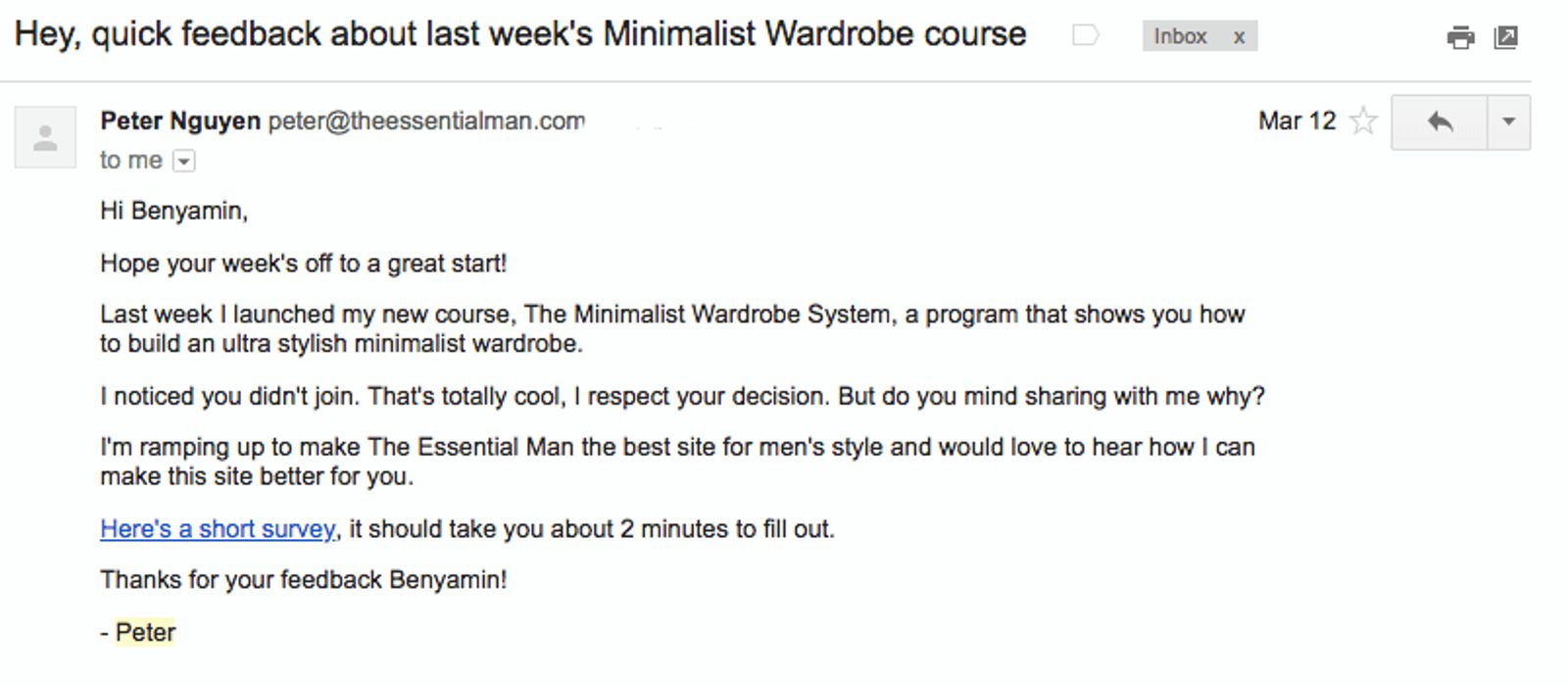
This is a solid email. It reminds me of the context, in case I haven’t been single-mindedly scrutinizing each email. It reaffirms that it’s ok I didn’t buy (don’t guilt-trip someone before you ask them for a favor). And it makes the ask small.
Note the emphasis on a “short survey” that will only take “2 minutes” to complete. I’m busy. I’m not about to spend 15 minutes answering questions about a product I didn’t even buy.
But hey, I’ll help a guy out. I didn’t buy his course, but 2 minutes? Maybe I can spare that.
When I click through to the survey, I get a simple Google form.

Which questions you ask your customers depends on your business. But I like the ones Peter chooses.
Question 1 qualifies the responses. If someone would never consider buying Minimalist Wardrobe, we probably don’t care about their responses.
Question 2 helps Peter figure out which concerns are the most important to address. What are most people choosing? Put more emphasis on that barrier in the copy.
Question 3 is a free response. This makes sure that people aren’t hemmed in by the choices in question 2 (i.e. they can list a different barrier), and also gives Peter the chance to collect some voice of customer language.
And the optional question 4 asks what other resources prospects are using. With this info, Peter can do more research on those resources, and maybe even explain why they don’t work within his funnel.
4 questions. 2 minutes. 1 email.
Following up with a research email is a great way to make the most of a missed customer.
How do you organize your funnel?
Let’s say you understand segmentation. You know you have to have personality. You’ve read Robert Cialdini’s Influence and you’re ready to flex your persuasion muscles.
Where do you start?
Expert insight: Andy Crestodina on welcome emails

“There's one email that gets a higher open rate than all others: the welcome-to-my-list email.
It's no surprise. The recipient is at their peak interest. They just converted into a subscriber, so they are want your content and trust your brand. Setting this auto-response it a no-brainer. Opens and click through rates are often 2x any other emails you send.
Think of it as just being polite. When someone starts listening, you should say hello, right? When someone asks for more, give them your best. I think of the welcome series as both smart marketing and common courtesy.”
– Andy Crestodina is a marketing expert, thought leader, and co-founder of Orbit Media Studios. He's an expert in SEO, web design, and using data to guide marketing strategy.
Everyone realizes, writing their first funnel, that there’s a huge difference between writing a bunch of emails and strategically organizing a persuasive sequence of messages.
How many emails should you write? How long should they be? How many segments do you need to send to, and how different are they?
First, think back to the stages of awareness.
Stages of awareness are your roadmap to building email funnels.
- Pain-aware prospects will probably need more emails
- Prospects in different stages of awareness need to be segmented
- Email length and content changes based on the specific objections you need to address to move people to the next stage.
We’ve already covered stages of awareness quite a bit, so this is mostly a reminder. The stage of awareness is crucial. Knowing your prospect’s stage of awareness tells you what to say, how much to say, and when to say it.
With that reminder, let’s talk more about the mechanics of an email funnel.
Ryan Johnson, the head copywriter of IWT and GrowthLab, approaches his funnels in layers, with each layer addressing a different goal of the funnel.

Source: GrowthLab
This approach, which he’s written about on GrowthLab and discussed on The Copywriter Club Podcast, moves gradually from big-picture questions to the content of each individual email.
Here’s an outline of the layers he uses to plan an email funnel.
- Offer: Know exactly what your offer is and who you are offering it to. Understand the features and benefits of that for your audience
- Structure: Check the deadlines and restrictions of your funnel. Is the offer time-limited? Is there a major event to plan around, like a webinar? Put these on the calendar for your funnel.
- Narrative: What is the underlying Big Idea of your funnel? What’s the single message you want people to remember? What are you trying to say?
- Sales Fundamentals: Scarcity. Future pacing. Social proof. The various persuasive techniques you want to use in this specific funnel.
- Emotional: What do you want people to feel at each stage of your funnel? Where do they need to start, and where do they need to end up to buy?
- Content: The words that go into each email
This layered approach, which I love, leaves the actual words of the content until the very end.
At that point, you’ll already know what you need to accomplish with each email. With an emotional journey, deadlines, and narrative planned out, you can get a sense of how many emails you’ll need to accomplish each goal.
Because you’ve layered your persuasive techniques with emotion, you don’t need to guess about what goes where.
The future-pacing email can slot in where you need to inspire awe.
You probably don’t want to use urgency while you’re still building curiosity.
Expert insight: Brennan Dunn on email funnel essentials

“Here’s the long and short of what I think should be a staple of any sequence:
- Progressive profiling (ideally through trigger links, surveying, or behavioral analysis) and then downstream optimizations based on that information (e.g. totally changing the pitch at the end)
- Leveraging personalization both in the emails and on the website (e.g. sales page) based on profiling
- Adding actual urgency and reiterating why someone joined your free funnel to begin with (profiling data)
- An elastic 'buffer' between the sequence and any pitching based on engagement (lower engaged = more education content prior to being pitched. Highly engaged = pitch ASAP)
- Tracking the value per lead entering a funnel and the revenue generated from it, both during any evergreen pitch AND lifetime (so you can track if they buy 6 months later or buy something more premium later on)”
– Brennan Dunn is a personalization expert. He is the founder of RightMessage and creator of Value My Funnel.
Combined with stages of awareness, segmentation, and all the other email fundamentals we’ve discussed, thinking in layers gives you the tools you need to build a funnel that converts.
When you nail this, hard questions fizzle up and disappear.
- How many emails should I send?
- What should I put in each email?
- How do I get people to buy?
The answers are unique to your email funnel – but if you’ve done the work of understanding your audience and their journey, the answers come to you without trouble.
Conclusion: Beyond “email” funnels
Email funnels are powerful. Email funnels convert. Email funnels can get you more customers – and more revenue – without doing more work.
But email isn’t the be all and end all of funnels. And the top of the funnel isn’t the only place you can use email.
Expert insight: Val Geisler on next steps

“The biggest thing I see overlooked in email funnels is the back half of the funnel. Most people are pretty well-versed in onboarding, sending emails to prospects before they become customers. But once they're customers? Nada.
Think about it like an actual kitchen funnel. You use a funnel to, say, pour flour from a bag into a container so it's ready for baking. But you don't do that just so the flour sits there in your cabinet. You pull that flour out, mix it with eggs and sugar, bake it into cookies, and then enjoy those cookies (maybe even with other people!). You might even pass that cookie recipe onto a friend for their future baking needs.
A email funnel doesn't stop at the point when the flour is poured (typically this is when we just focus on onboarding). Retention, reactivation, upgrading, win-back – all of these considerations need to go into a funnel for it to be the most successful it can be for your brand.”
– Val Geisler has been called an email geek, a copywriter, a marketer, and a real game changer (but you can just call her Val). You can learn more about email copywriting and email marketing strategy on her website.
As email gets overtaken by marketing automation, new possibilities for sales funnels appear.
- Messages on your site can reach visitors instantly
- Text messages can reach people wherever they are
- In-app messages coach people through what they need to know
- Real-life salespeople have more information – so they can reach out to the right prospects at the perfect moment
No matter the technology – when you understand stages of awareness and funnel fundamentals, you can create a compelling funnel that engages your prospects. And converts.

